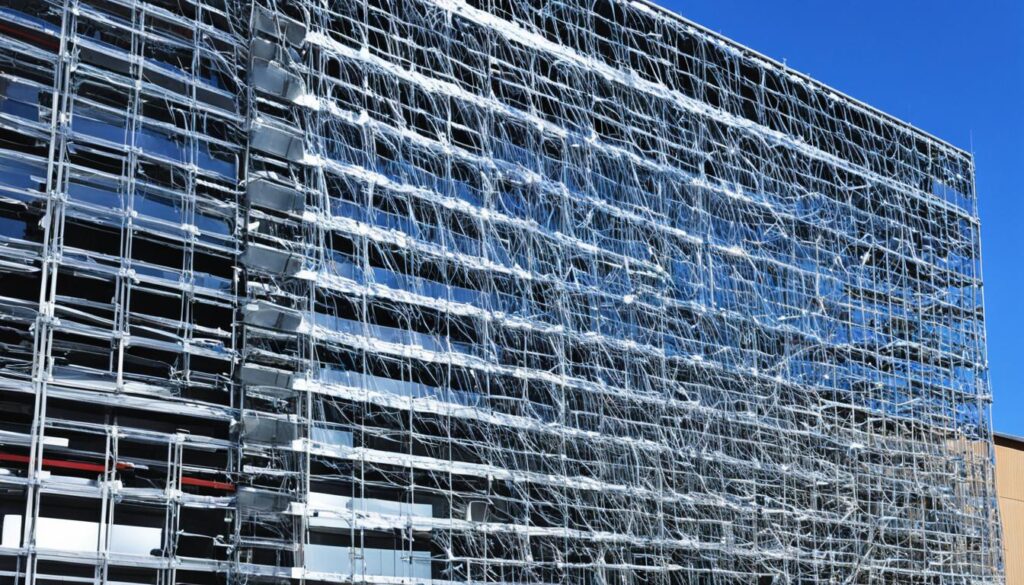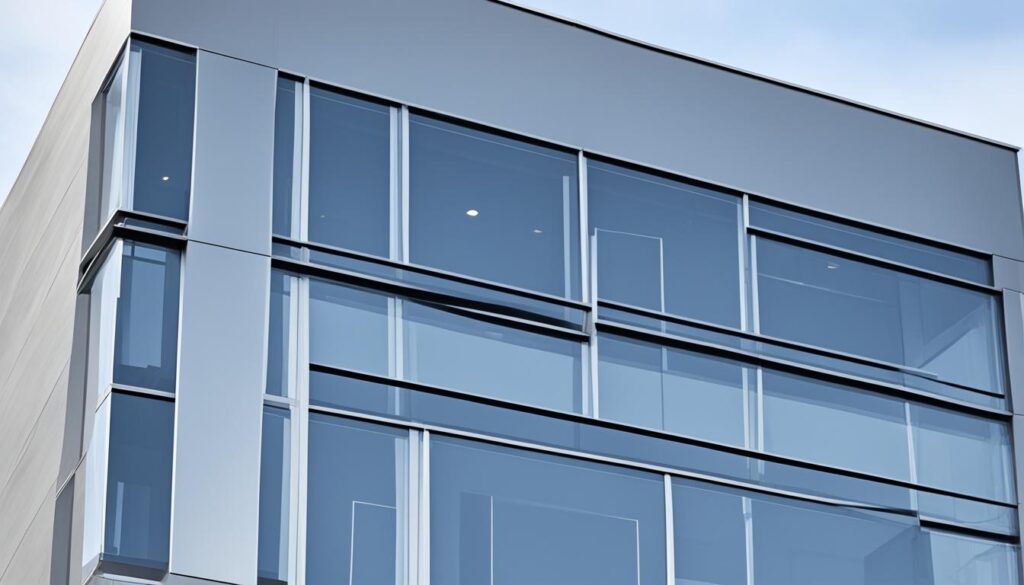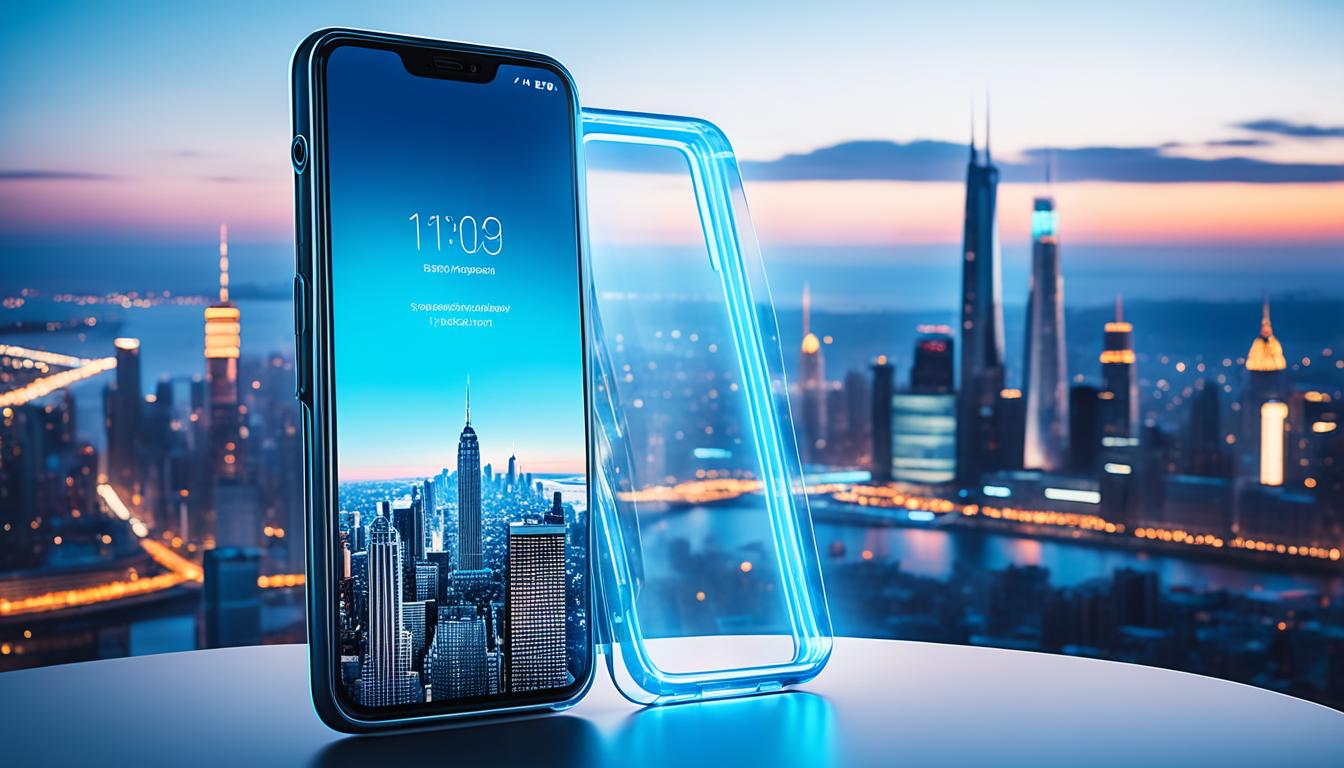Disclosure: This Post Contains Affiliate Links; We earn a commission on purchases.
In today’s digital age, electromagnetic fields (EMF) are all around us, emanating from various electronic devices and wireless communication technologies. While these advancements have brought convenience and connectivity, they have also raised concerns about potential health risks associated with prolonged exposure to EMF. As a result, there is a growing demand for architectural designs that incorporate EMF protection measures.
EMF shielding solutions play a crucial role in mitigating the impact of electromagnetic radiation on building occupants and sensitive equipment. By integrating shielding into structures, architects can create EMF-resistant designs that provide a safe and secure environment. Whether it’s healthcare facilities, research buildings, or residential structures, incorporating EMF protection architecture is essential to ensure the well-being of individuals and optimize building functionality.
EMF-blocking constructions can be achieved through the use of specialized materials and strategic design elements. Different materials, such as copper, aluminum, steel, and metal alloys, can be utilized for passive shielding, effectively blocking electromagnetic waves. Additionally, active shielding systems can be employed to generate balancing fields that counteract harmful EMF in certain situations.
Building designs for EMF mitigation should encompass a comprehensive approach, considering all aspects of shielding. It is crucial to ensure that all sides of a room are properly shielded and that penetrations in the shield are protected. Expert knowledge and collaboration with physicists or engineers are paramount in designing and implementing effective EMF protection in architectural designs.
Key Takeaways:
- Architectural designs can incorporate shielding to protect against electromagnetic fields (EMF).
- EMF shielding solutions are crucial in healthcare and research facilities.
- Two main types of shielding are electromagnetic shielding and ionizing radiation shielding.
- Materials such as copper, aluminum, steel, and metal alloys can be used for passive shielding.
- Active shielding systems generate balancing fields to counteract harmful EMF.
Types of Shielding in Medical and Research Buildings
In medical and research buildings, two main types of shielding are used to ensure safety and protect against harmful electromagnetic fields. These types of shielding are electromagnetic shielding and ionizing radiation shielding.
Electromagnetic shielding
Electromagnetic shielding is crucial for protecting sensitive devices and equipment from external interference. It effectively blocks radio frequencies and magnetic fields, preventing unwanted signals from disrupting critical operations. Common materials used for electromagnetic shielding include copper, aluminum, steel, and metal alloys.
Ionizing radiation shielding
Ionizing radiation shielding is essential to safeguard occupants from radiation exposure, particularly x-rays and radioactive materials. Lead is a widely used material for ionizing radiation shielding due to its exceptional ability to block ionizing radiation. In addition to lead, thick concrete walls or high-density concrete blocks may also be employed to increase protection against ionizing radiation.
Proper design and selection of shielding materials are pivotal factors in ensuring the effectiveness of shielding in medical and research buildings. A comprehensive understanding of electromagnetic shielding and ionizing radiation shielding is vital to safeguarding the well-being of occupants and preserving the integrity of sensitive equipment.
| Shielding Type | Shielding Materials | Protects Against |
|---|---|---|
| Electromagnetic Shielding | Copper, Aluminum, Steel, Metal Alloys | Radio frequencies, Magnetic fields |
| Ionizing Radiation Shielding | Lead, Thick Concrete Walls, High-Density Concrete Blocks | X-rays, Radioactive materials |
Examples of Architectural Shielding
Architects have found innovative ways to incorporate shielding into building designs to address electromagnetic wave propagation and protect against interference. These architectural shielding solutions play a crucial role in ensuring the integrity of wireless communication technologies and sensory architecture within buildings.
One notable example is the Signal Box, an architectural project designed by renowned Swiss architects Herzog & de Meuron. This structure features a unique Faraday cage facade, specifically designed to shield control equipment from external electromagnetic impulses. The Faraday cage, originally invented by Michael Faraday in the 19th century, is designed to create an electromagnetic “blind spot” by blocking the entry or escape of electromagnetic fields. The Signal Box’s Faraday cage facade effectively prevents interference and protects sensitive information within the control room from external electromagnetic waves.
“The Signal Box’s Faraday cage facade is a remarkable example of how architectural shielding can create a secure and protected environment for sensitive control systems.” – Architectural Digest
Another prominent building that is rumored to feature a Faraday cage facade is the National Security Agency Headquarters in Fort Meade, Maryland. The presence of a Faraday cage facade in this highly secure facility serves to prevent eavesdropping and interference from wireless spying techniques. By implementing a Faraday cage at the external level, the security of the wireless communication technologies within the facility and the confidentiality of sensitive information are enhanced.

These examples of architectural shielding demonstrate its efficacy in protecting against interference and ensuring the secure operation of wireless communication technologies. Additionally, the concept of full spectrum architecture has emerged, considering both visible and radio waves in the design process. Full spectrum design aims to enhance wireless connectivity while addressing the impact of electromagnetic wave propagation on buildings and occupants.
By integrating shielding into architectural designs, architects have the opportunity to create spaces that balance aesthetics with cutting-edge electromagnetic protection. These innovative approaches contribute to the overall goal of safeguarding sensitive information, promoting secure communication, and enhancing the overall functionality of modern buildings.
Shielding Materials and Installation
Architectural shielding plays a critical role in protecting against electromagnetic fields (EMF), and the choice of shielding materials is a key consideration in the design and installation process. Several materials are commonly used in architectural shielding, including:
- Copper foils: Heavy-duty copper foils provide excellent conductivity and are effective in blocking electromagnetic waves.
- Aluminium foils: Aluminium foils offer high strength and flexibility, making them suitable for various shielding applications.
- Steel sheet: Steel sheet is a durable option for shielding and provides robust protection against electromagnetic interference.
When selecting the appropriate shielding materials, factors such as shielding attenuation requirements, frequency range, and cost should be taken into account. The chosen materials should effectively attenuate the desired frequencies while being cost-effective for the project.
In addition to the choice of materials, proper installation is crucial to ensure maximum shielding performance. Careful attention must be given to the design and installation of apertures, or openings, in the shielding. These openings should be minimized and meticulously placed to prevent unwanted electromagnetic leakage.
Furthermore, the inclusion of waveguide vents is essential in shielded buildings, rooms, or enclosures. Waveguide vents allow for the passage of air while attenuating radiated interference. They are designed to maintain the integrity of shielding by effectively blocking electromagnetic waves while facilitating ventilation.
Ultimately, architects and engineers must evaluate the specific shielding requirements of each project and consult with experts to ensure the selection and installation of appropriate shielding materials and techniques.

Advantages of Copper Foils:
“Copper foils are widely used in architectural shielding due to their exceptional conductivity and effectiveness in blocking electromagnetic waves. Their high durability and flexibility make them a preferred choice for many shielding applications.”
Importance of Specification and Attenuation Testing
When implementing electromagnetic field (EMF) shielding in architectural projects, it is vital to establish a clear specification that outlines the required level of shielding attenuation across a specific frequency range. However, this information may not always be readily available at the outset of a project. In such cases, conducting thorough site surveys becomes crucial to quantify background field strengths and determine the appropriate level of attenuation needed.
European EMC Products, a leading provider of shielding solutions, recommends a comprehensive service encompassing design, supply, installation, and final attenuation testing. This ensures that the installed shielding aligns with the original specification, validating its effectiveness in safeguarding against electromagnetic fields.
Importance of Specification
Accurate specification is the foundation for successful EMF attenuation in architectural projects.
A clear and precise specification sets the benchmark for shielding attenuation. It outlines the performance requirements, enabling architects, engineers, and suppliers to design and implement appropriate shielding solutions that effectively mitigate electromagnetic fields. By specifying the desired level of attenuation and the frequency range, professionals can ensure the optimal protection of sensitive equipment and occupants in the building.
Site Surveys and Field Strength Evaluation
Site surveys quantify background field strengths and guide the determination of attenuation levels.
Site surveys play a crucial role in assessing the existing electromagnetic environment and identifying potential sources of interference. Conducting thorough surveys helps quantify background field strengths and provides valuable insights into the required levels of shielding attenuation. Armed with this information, architects and designers can select the most suitable shielding materials and design solutions to achieve the desired electromagnetic protection.
Final Attenuation Testing
Final attenuation testing confirms that the installed shielding meets the required specifications.
To ensure the efficacy of the installed shielding, final attenuation testing is essential. This testing procedure verifies that the shielding system effectively attenuates electromagnetic fields within the specified frequency range. By conducting comprehensive attenuation testing, architects and project stakeholders can have confidence in the performance of the shielding system and uphold the safety and protection of the building’s occupants and sensitive equipment.
| Benefits of Specification and Attenuation Testing |
|---|
| Ensures the desired level of shielding attenuation is achieved |
| Validates the effectiveness of the installed shielding |
| Guarantees the safety of occupants and sensitive equipment |
| Provides confidence in the electromagnetic protection of the building |
By prioritizing specification and conducting thorough attenuation testing, architects and engineers can ensure that shielding solutions are designed, installed, and tested to the highest standards. This commitment to excellence safeguards against potential risks associated with electromagnetic fields and creates a safe and secure environment for all.
Full Spectrum Design and Wireless-Friendly Buildings
Full spectrum design is an innovative approach that extends beyond the visible portion of the electromagnetic (EM) spectrum, encompassing radio waves as well. This comprehensive design strategy takes into account the permeability of building materials to radio frequency (RF) signals, enabling the creation of wireless-friendly buildings.
Researchers and engineers have been exploring the potential of metamaterials and frequency selective surfaces in architectural design. These materials possess unique properties that allow them to actively change states, reflecting or permitting radio waves to pass through as needed. This flexibility in electromagnetic (EM) propagation offers architects the opportunity to optimize wireless connectivity within buildings while addressing the impact of electromagnetic radiation.
Intelligent walls are dynamic elements of full spectrum architecture that can adjust their properties to achieve optimal wireless system performance. By reconfiguring themselves according to specific requirements, they ensure seamless wireless communication and support the ever-evolving needs of modern buildings.
Metamaterial engineering has paved the way for new possibilities in architectural design. These engineered materials exhibit properties not found in nature, allowing architects to create structures that are highly responsive to wireless infrastructure. By leveraging the principles of metamaterials, architects can design wireless-friendly buildings that provide optimal connectivity while considering the impact of electromagnetic radiation on occupants and the environment.
Incorporating full spectrum design and wireless-friendly principles into architectural projects offers numerous advantages. Buildings that are designed with the specific goal of enhancing wireless connectivity can provide seamless data transfer and support emerging technologies such as the Internet of Things (IoT) and 5G networks.
Simultaneously, architects must consider the potential health effects of electromagnetic radiation on occupants. The use of metamaterials and other advanced engineering techniques allows architects to strike a balance between connectivity and protecting the well-being of building occupants.
This forward-thinking approach to architectural design presents exciting opportunities for creating buildings that are not only aesthetically pleasing but also responsive to wireless infrastructure and tailored to the needs of modern society.
Engaging with the Electromagnetic Landscape in Architecture
Engaging with the electromagnetic landscape in architecture involves understanding and addressing the presence of electromagnetic radiation. Unlike visible light, electromagnetic radiation cannot be observed directly, requiring the use of hardware and software tools to measure and represent EM signals.
Material properties and spatial configurations affect signal propagation, and interventions can be designed to control connectivity and privacy. Examples include Mathieu Bujnowskyj’s mobile pavilions that disconnect users from digital signals and Space Caviar’s RAM house, which creates a space of selective autonomy from wireless communication.
“Architectural design is not limited to physical structures; it involves navigating the invisible electromagnetic landscape. By understanding the behavior of electromagnetic radiation and utilizing appropriate tools and materials, architects can create spaces that harmonize connectivity and privacy while mitigating the potential health concerns associated with excessive exposure to electromagnetic fields.”
While there are interactive installations that react to wireless signals, there is a need for a deeper integration of electromagnetic considerations in architectural design, fostering collaboration between communication engineers and architects.
The Radar-Absorbent Material (RAM) House
One exemplary concept that showcases the integration of electromagnetic considerations is the Radar-Absorbent Material (RAM) House. This innovative architectural design incorporates specially engineered materials to minimize the reflection and absorption of electromagnetic radiation, creating an environment that provides enhanced connectivity and privacy.
The RAM House features state-of-the-art materials and permeability techniques that absorb and dissipate electromagnetic radiation, reducing the potential for interference and improving overall electromagnetic performance within the structure. This sensitive integration of electromagnetic principles into architectural design demonstrates the profound impact that an intentional focus on connectivity, privacy, and electromagnetic radiation can have in creating a harmonious living and working environment.
Conclusion
Architectural designs that incorporate shielding for EMF protection are essential in ensuring building safety and mitigating the harmful effects of electromagnetic fields. By using materials like copper, aluminum, and steel, electromagnetic waves can be blocked or contained to create safer environments. Proper design, installation, and selection of shielding materials are crucial in optimizing the effectiveness of EMF protection in architectural designs.
In order to successfully integrate shielding into buildings, collaboration between architects, physicists, and engineers is necessary. By considering the impact of electromagnetic radiation and implementing the appropriate architectural designs, spaces can be created that not only prioritize aesthetics but also provide cutting-edge EMF shielding solutions for safer environments.
With the increasing concerns about the potential health risks associated with prolonged exposure to electromagnetic radiation, the importance of EMF protection in architectural designs cannot be overstated. By incorporating shielding integration and EMF mitigation into their projects, architects and designers can ensure building safety and provide peace of mind to occupants. The continuous advancements in technology and materials offer new possibilities and solutions for creating buildings that strike a balance between functionality, aesthetics, and EMF protection.
Source Links
- https://www.archtoolbox.com/shielding-in-buildings/
- https://www.euro-emc.co.uk/product/architectural-shielding
- http://digicult.it/news/architettura-tra-condizioni-atmosferiche-e-radiazioni-elettromagnetiche-parte-2/

Subscribe to Our Newsletter










